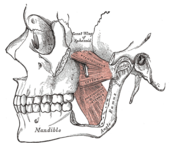TMJ - TemporoMandibular Joint
Evaluation and Treatment of TEMPOROMANDIBULAR DISORDER (TMD)
 TMJ is ball and socket joint that allows the lower jaw to open, close, and move forward, sideways when chewing, speaking, and yawning. There's one on each side of the face. The joints are about 1 cm in front of the ears.
TMJ is ball and socket joint that allows the lower jaw to open, close, and move forward, sideways when chewing, speaking, and yawning. There's one on each side of the face. The joints are about 1 cm in front of the ears.
Malfunction on 1 side can cause asymmetric shift and muscle imbalance. Both sides can be involved as well. Sometimes the jaw will stay shut or does not open normally, causing pain and problems with eating, chewing, and speaking.
Sometimes excessive yawning will also cause subluxation or dislocation of the jaw if there's already a weakness.
TMJ also have muscle attachments to the temples causing tension headaches and jaw pain, such as clenching teeth when one is under stress, during lifting or hard manual tasks, concentrated effort, or clenching during sleep.
Abnormal muscle tension and poor posture of the neck and shoulders can also affect the alignment of the jaw. If the head turns up too much, then the jaw tend to open too much. More muscle contractions then are required to hold the jaw in alignment.
Dysfunctions occur when the TMJ disc cushion slips, catches, or the muscles are out of rhythm, leading to muscle spasm, pain and inflammation.
When in a state of muscle imbalance, subluxation of the joint is also possible.
We treat the following conditions related to the TMJ and surrounding areas:- Associated neck pain/trauma
- Headaches (i.e. cervicogenic headache)
- Muscle tightness/tender points
- Dental Occlusion alterations
- Parafunction habits (i.e. bruxism, clenching)
- TMJ degeneration
- TMJ disc displacement
- TMJ hypermobility
- TMJ hypomobility/mouth opening limitation
- TMJ surgery
- Ultrasound to provide deep heat to the joints
- Manual therapy to release muscle tension inside and outside the mouth
- Relieve tension in head and neck
- TMJ mobilization
- Jaw exercises
- Splinting to help stabilize and provide correct alignment of the jaw
- Shoulders, neck, back spine exercises
- Correct posture, alignment of the head, neck, shoulders
- Reducing muscle tension in the upper body and neck
- Correct lifting mechanics to prevent abnormal pressure

